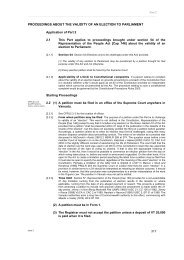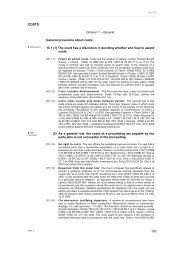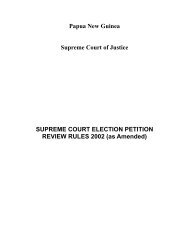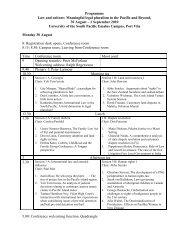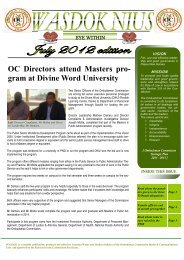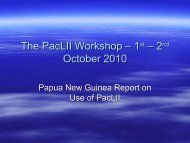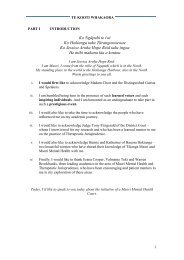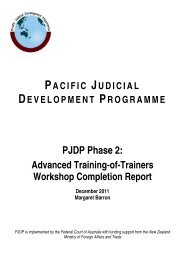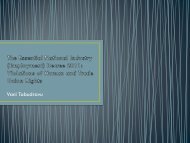- Page 1 and 2:
Tuvalu Island Courts Bench Book Pro
- Page 3 and 4:
nor this Book would be as effective
- Page 5 and 6:
2 Conduct in Court 2.1 Preparing fo
- Page 7 and 8:
E Civil 1 Introduction 2 Civil Juri
- Page 9 and 10:
Pacific Judicial Education Programm
- Page 11 and 12:
Tuvalu Island Courts Bench Book Jun
- Page 13 and 14:
The independence of the Judiciary i
- Page 15 and 16:
The Constitution gives immunity to
- Page 17 and 18:
2.2 General Characteristics of the
- Page 19 and 20:
2.4 A Brief Description of the Cour
- Page 21 and 22:
The Sovereign in Council is the Que
- Page 23 and 24:
The following people may not be app
- Page 25 and 26:
3.6 Procedures Procedures establish
- Page 27 and 28:
Any statute or regulation passed af
- Page 29 and 30:
Customs must be taken into consider
- Page 31 and 32:
5.3 The Important Rules of Evidence
- Page 33 and 34:
For example, X has been prohibited
- Page 35 and 36:
Term Adjournment Meaning When a cas
- Page 37 and 38:
Impartial/Impartiality Being free o
- Page 39 and 40:
Tort A wrong committed by one perso
- Page 41 and 42:
Tuvalu Island Courts Bench Book Jun
- Page 43 and 44:
1.2 “Do Right” Integrity You sh
- Page 45 and 46:
This principle touches several diff
- Page 47 and 48:
2 Conduct in Court 2.1 Preparing fo
- Page 49 and 50:
• Never make fun of a party or wi
- Page 51 and 52:
It is your responsibility to ensure
- Page 53 and 54:
C: CRIMINAL This part describes the
- Page 55 and 56:
1 Criminal Jurisdiction of the Isla
- Page 57 and 58:
Act Section Description Penal Code
- Page 59 and 60:
Act Section Description Marriage Ac
- Page 61 and 62:
4 How a Case Gets to Court Criminal
- Page 63 and 64:
In any case before the Court, the d
- Page 65 and 66:
The person should be in attendance
- Page 67 and 68:
6.4 The Defence The defence does no
- Page 69 and 70:
Mental capacity (called the mens re
- Page 71 and 72:
8.1 Principles Governing Decision M
- Page 73 and 74:
8.3 A Structured Approach to Making
- Page 75 and 76:
Criminal Decision Format Follow thi
- Page 77 and 78:
9.1 Principles of Sentencing It is
- Page 79 and 80:
Customary considerations Custom may
- Page 81 and 82:
9.4 Types of Sentence The Island Co
- Page 83 and 84:
Discharge (Absolute) Imposed where
- Page 85 and 86:
When a case has been decided on app
- Page 87 and 88:
Assistance for the young person Usu
- Page 89 and 90:
11.4 Sentencing Young Offenders Par
- Page 91 and 92:
D: COMMON OFFENCES This part is a q
- Page 93 and 94:
The following offences are those th
- Page 95 and 96:
Drunk and disorderly Section s167(d
- Page 97 and 98:
Defences If the prosecution has pro
- Page 99 and 100:
Words or behaviour There must be go
- Page 101 and 102:
Public place The prosecution must p
- Page 103 and 104:
Legal excuse The prosecution must p
- Page 105 and 106:
Took and carried away The prosecuti
- Page 107 and 108:
The prosecution must provide eviden
- Page 109 and 110:
Larceny (theft) or destruction of t
- Page 111 and 112:
This is a subjective test - it is t
- Page 113 and 114:
In Court, the prosecution should id
- Page 115 and 116:
Larceny (theft) of or destruction/d
- Page 117 and 118:
Defences If the prosecution has pro
- Page 119 and 120:
Larceny (theft) of or damage to fix
- Page 121 and 122:
For a charge of stealing: Took and
- Page 123 and 124:
Going armed in public Section s25 P
- Page 125 and 126:
Sentence The maximum penalty is imp
- Page 127 and 128:
Place The fight may be in a public
- Page 129 and 130:
Driving while unlicensed Section s1
- Page 131 and 132:
Breach of provisional driving licen
- Page 133 and 134:
Careless driving Section s20 Traffi
- Page 135 and 136:
Taking a vehicle without authority
- Page 137 and 138:
Driving while impaired by alcohol o
- Page 139 and 140:
Speeding Section reg7(1), (2), (3)
- Page 141 and 142:
Traffic Act offences where no speci
- Page 143 and 144:
Drunkenness on licensed premises Se
- Page 145 and 146:
Charges under s98(1) License holder
- Page 147 and 148: Supplying a minor Section s99(1) an
- Page 149 and 150: Under age drinking on licensed prem
- Page 151 and 152: Refusal to leave licensed premises
- Page 153 and 154: Possession of a dangerous weapon on
- Page 155 and 156: Possession of a dangerous weapon wh
- Page 157 and 158: Drinking alcohol in prohibited publ
- Page 159 and 160: The following offences are usually
- Page 161 and 162: • The person named in the charge
- Page 163 and 164: other person. This is a subjective
- Page 165 and 166: possession. Possession does not hav
- Page 167 and 168: Assault causing actual bodily harm
- Page 169 and 170: Assault with intention to commit fe
- Page 171 and 172: Assaulting, resisting or wilfully o
- Page 173 and 174: Assaulting, resisting or obstructin
- Page 175 and 176: Assaulting any person in execution
- Page 177 and 178: Simple larceny (theft) Section ss25
- Page 179 and 180: The accused will have to establish
- Page 181 and 182: Tuvalu Island Courts Bench Book Jun
- Page 183 and 184: 3 Civil Procedure Writ filed. Date
- Page 185 and 186: Upon a request for a subpoena of a
- Page 187 and 188: 5 Judgment Once all the evidence ha
- Page 189 and 190: If you order imprisonment for defau
- Page 191 and 192: 6 Contracts 6.1 What is a Contract?
- Page 193 and 194: Certainty The general rule is that
- Page 195 and 196: A breach of contract can take many
- Page 197: Validity Is there any reason to mak
- Page 201 and 202: 8 Appeals and Revisions 8.1 Appeals
- Page 203 and 204: F: FAMILY This part generally descr
- Page 205 and 206: 1 Family Jurisdiction See s5 and Sc
- Page 207 and 208: 2 Marriage The law on Marriage is f
- Page 209 and 210: 2.3 The Special License Hearing Thi
- Page 211 and 212: 3.3 How a Divorce Case Gets to Cour
- Page 213 and 214: The Court may forego attempts at re
- Page 215 and 216: Divorce Checklist Jurisdiction Are
- Page 217 and 218: If you are not satisfied that adequ
- Page 219 and 220: 4.6 Interim Hearing An interim-hear
- Page 221 and 222: 5 Matrimonial Property In divorce p
- Page 223 and 224: 6.3 How an Application for a Mainte
- Page 225 and 226: If the Island Court makes a mainten
- Page 227 and 228: CRIMINAL FORMS: 1. Charge 2. Summon
- Page 229 and 230: CIVIL FORMS: 11. Writ of summons 12
- Page 231 and 232: FAMILY FORMS: 17. Divorce petition
- Page 233 and 234: CASES: High Court of Tuvalu 2002 an



